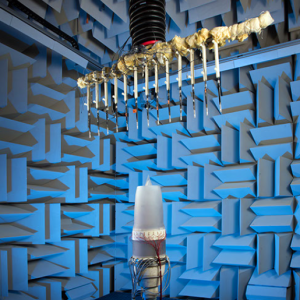Acoustical Testing Laboratory

When you want to listen to something carefully, what do you do? You turn off other noisy things, close the door and listen closely. That’s just what you can do in the Acoustical Testing Laboratory (ATL). The ATL is an anechoic (without echoes) chamber. The 34-inch deep fiberglass wedges are designed to absorb 99% of incident sound above 100 Hz. This means that the sound field inside the room is essentially the same as if you were suspended in an infinitely large room with no sound reflections, which is the ideal environment for making acoustic measurements. Dense rubber material in the walls and ceiling of the ATL absorb or reflect sound from the outside. A separate control room is attached for any noisy equipment or persons needed to perform the measurements. The ATL has a special metal grate floor to allow sound to pass through to the wedges below. The floor wedges can also be removed to reveal a concrete floor below, making the ATL a hemi-anechoic chamber, which is used for certain kinds of acoustic tests.
Research performed in ATL to support the Aeronautics Research Mission Directorate (AMRD) includes determining noise sources and levels from electric motors, calibrating microphone equipment, measure acoustic properties, and generating sound radiation and shielding databases for model aircraft engines. Recent tests in the ATL have included electric motor noise measurements for advanced air mobility and a scale model of a supersonic aircraft engine inlet.
To get a copies of NASA technical reports related to research in the Acoustical Testing Laboratory, please visit the NASA Technical Reports Server (NTRS)
